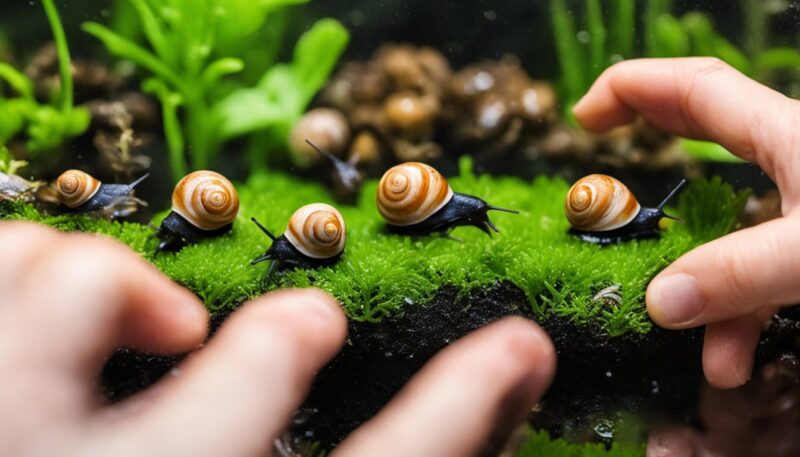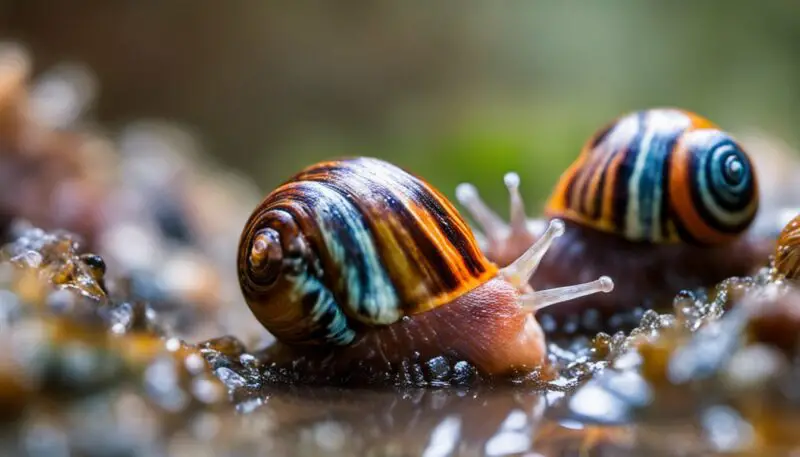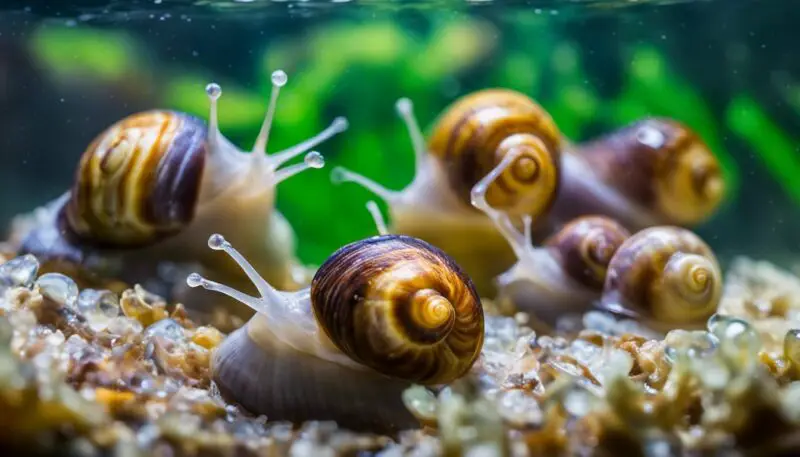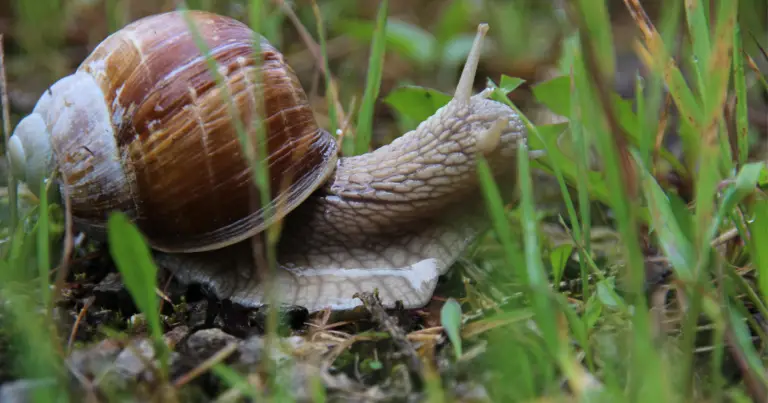How Long Do Nerite Snails Live?

Nerite snails are popular aquatic creatures often found in freshwater aquariums due to their impressive algae-eating abilities. They come in different species, from zebra nerite snails to horned nerite snails. If you are considering adding nerite snails to your aquarium or are simply curious how long Nerite snails live, you have come to the right place.

The lifespan of a nerite snail can vary depending on various factors such as temperature, diet, tank mates, breed, and habitat. Most nerite snails live between 2 to 3 years in a well-maintained aquarium. However, some nerite snails can live anywhere from 3 to 6 years, and there have even been cases of them living up to 11 years when provided with optimal care and living conditions.
In conclusion, by ensuring proper care, including appropriate tank size, water parameters, and a healthy diet, you can maximize the lifespan of your nerite snails. These versatile aquatic creatures are not only fascinating, but they also play an essential role in keeping your aquarium clean and algae-free.
Contents
Table of Contents
General Overview of Nerite Snails

Nerite snails are popular for aquarium enthusiasts due to their algae-eating habits and colorful, unique shell patterns. These snails belong to the Neritidae family and are in various tropical and subtropical aquatic environments worldwide. This section will teach you about the different types of nerite snails and their features.
Types of Nerite Snails
There are several types of nerite snails that you can consider for your aquarium. Each one has its distinctive appearance and characteristics:
- Zebra Nerite Snail: As the name suggests, these snails have a striped pattern resembling that of a zebra. They are popular for their striking appearance and ability to consume large amounts of algae.
- Horned Nerite Snail: These snails feature small, horn-like projections on their shells, giving them a unique appearance. They are great algae eaters and can enhance the aesthetic appeal of your tank.
- Tiger Nerite Snail: With bold stripes and vibrant colors, the tiger nerite snail resembles the zebra nerite snail. They are also efficient at controlling algae growth in your aquarium.
- Black Racer Nerite Snail: Recognized by their sleek, dark shells, black racer nerite snails can make a striking addition to your tank. Like other nerite snails, they are excellent algae eaters.
- Red Racer Nerite Snail: These snails have gleaming red shells that can add color to your aquarium. They are known for their algae-eating capabilities as well.
- Olive Nerite Snail: With a smooth, olive-colored shell, these snails might appear more subdued than their vibrant counterparts, but they are just as effective at controlling algae growth.
You can control algae growth and add an exciting visual element to the environment by choosing one or a combination of these nerite snails for your aquarium. While they serve a practical purpose, they also offer an opportunity to admire the diversity in appearance and behavior among the different types of nerite snails.
Habitat and Tank Requirements

Tank Size and Conditions
Your Nerite snail’s habitat is essential for its healthy growth and long lifespan. Providing them with an appropriate tank size and water conditions is necessary for a well-maintained environment. Although Nerite snails are adaptable, they are typically found in mangrove swamps and coastal inlets. A proper freshwater aquarium setup is crucial to imitate their natural habitat.
A tank size of at least 5 gallons is recommended for Nerite snails under 1 inch long, while a 10-gallon aquarium would be suitable for snails over an inch. To house a group of 4 Nerite snails, consider a 20-gallon tank. Ensure the tank’s water parameters are stable, with a pH level of 7.0-8.5 and a temperature range of 72-78°F.
Essential Tank Elements
To establish a comfortable environment for your Nerite snails, certain elements are necessary in the tank:
- Substrate: Opt for a soft substrate, like fine sand or gravel, to prevent their delicate undersides from potential injuries.
- Lighting: Moderate lighting suits these creatures as they prefer dimmer environments. However, slight fluctuations in light conditions can be tolerated.
- Driftwood, rocks, and surfaces: Create a stimulating environment by including driftwood, rocks, and smooth surfaces for your snails to crawl on and explore. These elements will also promote algae growth, serving as their natural food source.
- Plants: Introduce live plants in your fish tank as they improve water quality and offer additional surfaces for the snails to graze on.
By carefully curating your Nerite snails’ habitat with the right tank setup, you’ll contribute to their overall well-being, increasing their chances of living a long, healthy life in your aquarium.
Lifespan and Health of Nerite Snails

Nerite snails typically live between 2 to 3 years in a well-maintained aquarium, but some have lived up to 6 years or even longer. Various factors affect their lifespan, such as temperature, diet, tank mates, and habitat. By ensuring a healthy environment and knowing the potential health concerns, you can provide the best care for your nerite snails and help them thrive.
Health Concerns and Treatment
Shell Health: An important aspect of nerite snail health is their shell. Poor water quality and improper water parameters can lead to shell deterioration or pitting. You can effectively keep your snail’s shell healthy by maintaining the right water conditions. Ensuring a proper diet with calcium-rich foods also contributes significantly to shell health.
Breeding Nerite Snails: Nerite snails typically do not reproduce in freshwater aquariums, as they require brackish water conditions for their larvae to survive. Keeping their reproductive rate in check is important, as overcrowding may negatively affect their overall health and lifespan.
Disease and Health Issues: Common health issues faced by nerite snails include fungal infections, parasitic infestations, and bacterial infections. Early identification of any health issues is crucial for successful treatment. Monitor your snail’s behavior, physical appearance, and waste to catch any warning signs. Remove any dead snails from the tank promptly, as decomposing snails could introduce potential diseases to the rest of the tank’s inhabitants.
Water Quality Issues: Proper water quality is vital for the health and longevity of nerite snails. Inadequate water conditions can lead to stress and disease, ultimately affecting their lifespan. Test your water parameters regularly and adjust as necessary. The ideal water parameters for nerite snails are a temperature of 72-78°F, a pH level of 7.0-8.0, and a hardness level of 12-18 dKH.
You can support their health and extend their lifespan by giving your nerite snails a well-balanced diet, a suitable habitat, and proper care. Stay vigilant to any changes in their appearance or behavior, as this may indicate potential health concerns that require immediate attention.
5 Reasons Why Your Nerite Snails Keep Dying
Feeding and Diet
Common Foods
Nerite snails are primarily herbivorous creatures, meaning they mainly consume plant matter in their diet. Alginate is one of the primary foods nerite snails love to eat, making them excellent algae eaters for your aquarium. They also munch on biofilm, helping to keep your tank clean and free from unwanted growth.
A calcium-rich diet is essential for their shell development, so ensure their food sources contain an adequate amount of this nutrient. You can supplement their diet with vegetables, such as spinach and zucchini, to ensure that they receive proper nutrition.
Feeding Practices
Feeding nerite snails is straightforward, as they graze on the algae and biofilm readily available in your tank. However, you should be mindful of their appetite and ensure they do not go hungry. To keep a balanced diet for your snails, consider providing them with additional food sources, such as algae wafers or blanched vegetables, when the natural growth of algae is insufficient.
Be cautious not to overfeed your snails, as this can lead to poor water quality and other issues within the aquarium. A proper balance of food and external supplements will help maintain their overall health and extend their lifespan, which ranges between 2 to 3 years.
Reproduction and Breeding

Breeding Conditions
Nerite snails are fascinating creatures that are often added to freshwater aquariums. They do not reproduce in freshwater aquaria, as they require brackish water for successful breeding. Their reproduction process involves a male and female snail, unlike some other snail species that are hermaphrodites. If you want to breed your nerite snails, you must create a separate tank with brackish water conditions to ensure the success of their reproduction.
Egg Laying and Hatching
Egg laying is an essential aspect of the nerite snail breeding process. Female nerite snails will lay eggs on surfaces such as aquarium glass or decorations. The eggs will then hatch after an incubation period of 20 to 25 days.
In brackish water conditions, the hatched larvae undergo a larval stage before developing into baby snails. These young snails will continue to grow and develop in the brackish water environment until they reach maturity. Once they are mature, you can consider transferring them to a freshwater aquarium if desired.
However, it is important to remember that different nerite snail species may have slightly varying lifespans and breeding requirements. By providing the appropriate care and environment, you can increase the chances of successfully breeding your nerite snails and raising healthy offspring.
Compatibility and Tank Mates

Good Tank Mates
Nerite snails are quite hardy and adaptable, making them compatible with various tank mates. They thrive in freshwater and brackish environments, with a preference for temperatures ranging from 72 to 78°F. As herbivores, nerite snails primarily consume algae and other plant materials, so having live plants in your aquarium benefits their diet.
Some good tank mates for nerite snails include:
- Tetras: These small, peaceful fish are known for their vibrant colors and get along well with nerite snails.
- Corydoras Catfish: These bottom-dwelling fish share a similar temperament and appreciate similar water conditions as nerite snails.
- Dwarf shrimp: Both nerite snails and dwarf shrimp are excellent algae eaters, helping to keep your tank clean.
- Betta fish: Although bettas can sometimes be territorial, they generally coexist peacefully with nerite snails due to their difference in appearance and feeding habits.
Fish to Avoid
When choosing tank mates for your nerite snails, avoiding aggressive or predatory fish that might see snails as prey is essential. Some fish that are not suitable companions for nerite snails include:
- Cichlids: Many cichlid species can be aggressive and may attack or eat nerite snails.
- Loaches: Some loach varieties, like the clown loach or yoyo loach, are known to feed on snails and should be avoided.
- Pufferfish: Puffers can be especially dangerous for nerite snails, as they actively hunt and feed on snails.
By carefully considering your nerite snails’ compatibility, temperament, and dietary needs, you can create a harmonious and diverse aquarium community where all inhabitants thrive.
Types of Water Conditions

Freshwater Conditions
Nerite snails thrive in stable water conditions with optimal parameters in freshwater environments. Maintaining an appropriate water temperature between 20-26°C (60-79°F) 1. Water hardness should be 6-12 dH, while the pH should be between 6.0 and 8.0 1.
Regular monitoring of your aquarium’s water quality is crucial for the health of your nerite snails. Poor water conditions can lead to stress and diseases, which can shorten their lifespan. Some ways to ensure a healthy freshwater environment for your nerite snails include:
- Frequent water changes to maintain water quality
- Testing for ammonia, nitrite, and nitrate levels regularly
- Using a well-filtered aquarium to remove debris and waste
Brackish Water Conditions
Although nerite snails are often found in freshwater aquariums, some species can be kept in brackish water environments. Brackish water contains more salt than freshwater but less than saltwater, creating a unique environment for certain types of nerite snails. These snails will require slightly higher water hardness levels and a pH similar to their freshwater counterparts.
To maintain a proper brackish water environment for your nerite snails, it’s crucial to consider the following:
- Monitor salinity levels consistently to ensure they are within the acceptable range for your specific species of snail
- Keep stable water temperature and pH levels similar to those required in freshwater environments.
- Follow proper aquarium maintenance practices, such as water changes and filtration, to maintain water quality
By providing the right water conditions for your nerite snails, you can help them live a healthy and happy life, with lifespans averaging between 2 to 3 years under optimal care.
How Long Do Nerite Snails Live

Taking care of nerite snails can be a rewarding experience, especially if you are interested in keeping your aquarium clean and maintaining healthy tank mates. You can expect nerite snails to live for about 1 to 5 years, depending on their environment and the care you provide.
To ensure the well-being of your nerite snails, it is essential to meet their care requirements and maintain them properly. A 10-gallon tank or larger is ideal for housing them, as this will allow for ample space and water volume to maintain stable conditions. As your collection of nerite snails grows, consider upgrading to larger tanks to ensure they continue thriving.
Proper water parameters and clean conditions are crucial for nerite snail care. Regular water changes and a quality filtration system can prevent the build-up of harmful chemicals and toxins. Additionally, providing your nerite snails with a balanced diet of algae and supplementary foods will help them maintain their health and longevity.
It’s important to remember that while nerite snails are relatively low-maintenance pets, they still require attentive care to ensure their well-being. By understanding their needs and dedicating time to their care, you can enjoy watching these fascinating creatures beautify your aquarium and provide an efficient and natural cleaning service.
FAQs: How Long Do Nerite Snails Live
How Long Do Nerite Snails Live? What is the average lifespan of nerite snails in an aquarium?
The average lifespan of nerite snails in an aquarium is usually around 1-2 years. However, some species of nerite snails can live up to 5 years if proper care is taken. The lifespan of these snails can vary depending on factors such as their environment, diet, and care.
What factors affect the longevity of nerite snails in a tank?
Several factors can affect the longevity of nerite snails in a tank, including water temperature, tank size, water parameters, diet, and potential diseases. Ideally, nerite snails thrive at a temperature range of 72 to 78 degrees Fahrenheit. Ensure your tank has proper space and appropriate water parameters to ensure your snails live long and healthy lives.
Can nerite snail lifespan differ among species?
Yes, the lifespan of nerite snails can differ among species. Each nerite snail species has its own distinct appearance and characteristics, which can affect their average lifespans. You can find more information about the various types and their lifespans here.
How can proper care prolong nerite snails’ life?
Proper care can significantly prolong the life of nerite snails. Maintaining the appropriate water parameters, providing a balanced diet, and monitoring for potential diseases in your tank will all contribute to your snails’ overall health and longevity. Regularly clean their tank and keep track of any changes in their behavior to ensure they stay healthy and happy.
What are the signs of a nerite snail nearing the end of its life?
Signs of a nerite snail nearing the end of its life can include loss of appetite, slowed movement, and lack of response to stimuli. They may also show signs of shell deterioration or damage. If you notice any of these signs, it is crucial to monitor the snail closely and ensure its living conditions are optimal to prolong its life as much as possible.
What common mistakes can shorten the life of a nerite snail?
Some common mistakes that can shorten the life of a nerite snail include improper water parameters, overcrowded tanks, poor diet, and ignoring potential health issues. To prevent these issues, regularly check water quality, provide an adequately sized tank, offer a balanced diet, and monitor your snails closely for signs of illness or distress. Following these guidelines can avoid common mistakes and keep your nerite snails thriving in your tank.

![Can You Eat Apple Snails? [Read This First!]](https://allourcreatures.com/wp-content/uploads/2021/11/eating-snails-768x514.jpg)



![Do Snails Eat Grass? [Complete Answer]](https://allourcreatures.com/wp-content/uploads/2021/10/snails-eat-grass-768x519.jpg)
